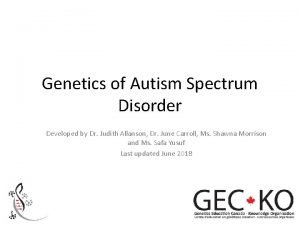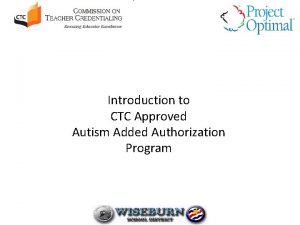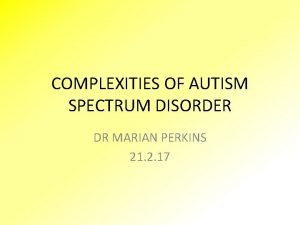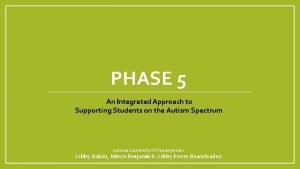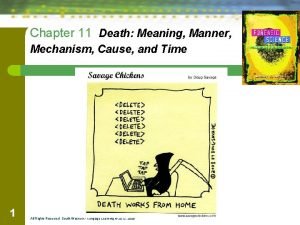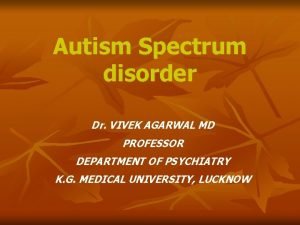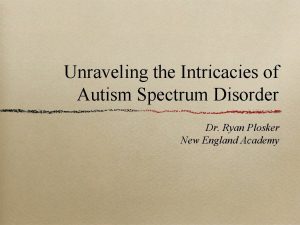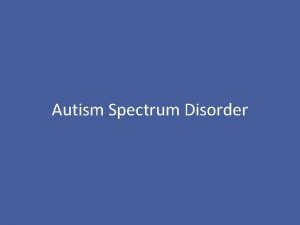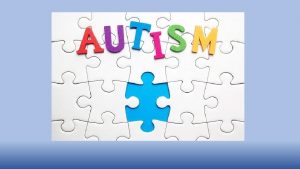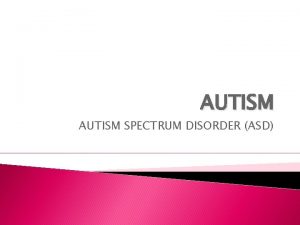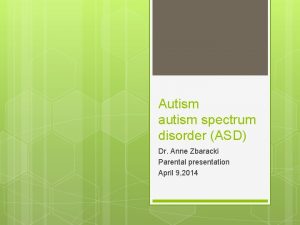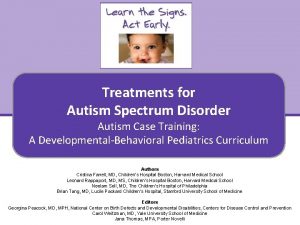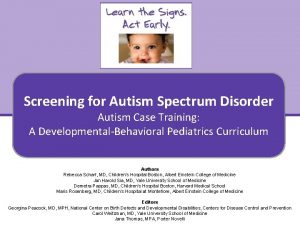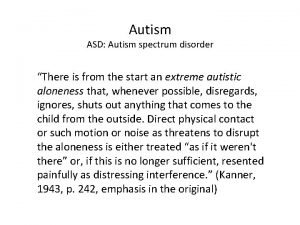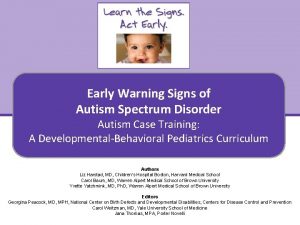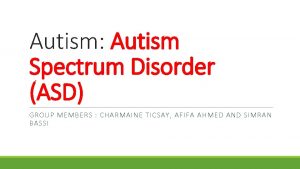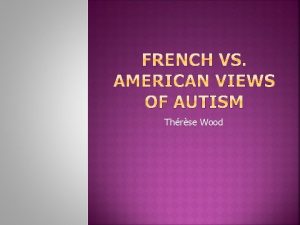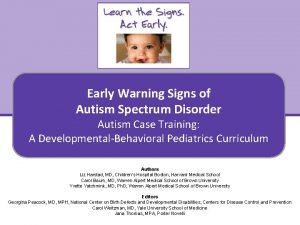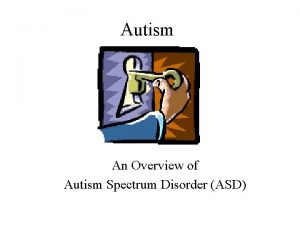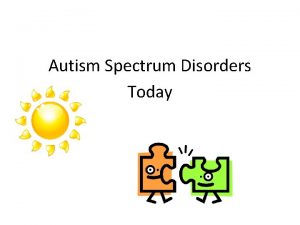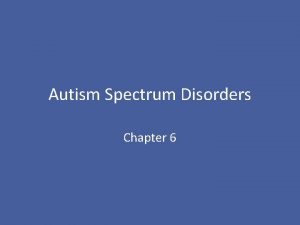Unraveling the Intricacies of Autism Spectrum Disorder Dr




































- Slides: 36

Unraveling the Intricacies of Autism Spectrum Disorder Dr. Ryan Plosker New England Academy

Neurological Profile

Neurological Profile Verbal Intelligence: • • • Verbal intelligence is a measure of verbal comprehension, ability to process verbal information and to think with words. It looks at language processing, reasoning, attention, verbal learning and memory. Example

Neurological Profile • • • With Asperger’s children, their verbal intelligence tends to be high. They verbally understand the world but often times they are inefficient at communicating it or communicating at developmentally appropriate levels. Impacted by motivation, attention and ability to process.

Neurological Profile Perceptual Reasoning (Performance IQ) • • Tends to be significantly weaker than their verbal abilities. Often see a significant splint between their ability to verbally understand the world and their ability to visually understand navigate it.

Neurological Profile Perceptual Reasoning: • • It assesses the child’s ability to examine a problem, draw upon visual-motor and visual spatial skills, organize their thoughts, create solutions and test them! It looks at preferences for visual information, comfort with novel and unexpected situations, or a preference to learn by doing (hands on tasks).

Neurological Profile Visual Motor Skills Visual Spatial Skills

Neurological Profile Working Memory: • • • It assesses children’s ability to memorize new information Hold it in short term memory, concentrate, manipulate the information to produce some result. It is critical in higher-order thinking, learning and achievement.

Neurological Profile • Working memory assesses concentration, planning ability, cognitive flexibility and sequencing skill. • It is sensitive to anxiety. • Critical in self-monitoring of behavior.

Neurological Profile Processing Speed: • • • Assesses child’s ability to focus, attend, quickly scan information and discriminate between information. Requires persistence and planning ability. Impacted by time, pressure and motor coordination.

Neurological Profile • Auditory Processing • Visual Processing

Sample Profile 15 Year Old, 10 th grade, Asperger’s Child Verbal IQ = 130 Perceptual Reasoning = 98 Working Memory = 80 Processing Speed = 60 (Can Intelligence Change? )

Sample Profile 8 Year Old, rd 3 grade, Asperger’s Child Verbal IQ = 150 Perceptual Reasoning = 140 Working Memory = 120 Processing Speed = 100

Cognitive Skill Verbal manipulation (the Frustration!) Generalization of skills Academic Strengths and Weaknesses Organizational Skills Child looks normal, has normal intellect but is not age appropriate.

Cognitive Skill Lack of reciprocity (It’s all about me!) The intelligence spectrum Verbal intelligence vs. Perceptual Reasoning Long term memory (School Tours) Cognitive rigidity Processing Speed

Autism Spectrum Profile • Attention Issues • Motivational Issues • Difficulty with novel and unexpected situations • Sensitive to anxiety • Difficulty holding information

Autism Spectrum Profile • Ability to self-monitor • Difficulty with time pressure • Production issues • Directing and planning behavior • Organizational weaknesses

Role of Executive Functioning The Executive Functioning System is responsible for: • Problem solving • Reasoning • Self-awareness • Attention • Social interaction

Role of Executive Functioning • Time management • Self-regulation • Task initiation • Goal directed behavior • Flexibility

Neurological Impact Anxiety Social Difficulty Depression Mania Time Pressure Processing Speed Impacts Brain Functioning

Neurological Melt Down • Peer interactions/social speed (Visual Processing) • Unclear Expectations – The Gray World • Social nuances – the hallways • Time pressure – We must get through • Teasing/Bullying – the impact • I get stuck/you get stuck

Social Behavior Peer Interactions Friendship Desires Social Cues Age Appropriate Behavior Facial Expressions Reciprocity of emotions (behaviors)

Social Behavior Avoidance of Eye Contact Personal Space Typical Play (peers) The need to control = behavior Leave me alone! Offensive comments

Asperger’s and Violence • • • Asperger’s doesn’t make a person more likely to commit a violent crime, some say it may affect the way a crime is carried out. Research suggests people with Autism do have a higher rate of aggressive behavior – outbursts, shoving or pushing or angry shouting – than the general population. However, people with autism or Asperger’s are not more likely to commit violent crimes than members of the general population, but they say in very rare cases, it can happen.

Asperger’s and Violence • Violent thoughts, ideas and comments. • When do Asperger kids become violent?

Language Characteristics Appropriate Conversations (i. e. Horses) Use of Pragmatic Language Literal understanding The black and white world Predicting the conversation Irrelevant comments

Language Characteristics Formalized speech Use of “big words” Creation of words Vocalization of thoughts (threats) Too much or too little?

Interests and Routines Collecting Gaming Computer/technology Disruption Need for Consistency

Classroom Challenges Control over activities Group work Rules and rigidity Questioning of Authority Content Challenges = teacher frustration Organizational Skills

Behavioral Challenges Our world or theirs? Did we set them up? Are they just stuck? Are they Neurologically able to handle what is being required? To the point, limited verbal, black and white requests.

Teaching Social Skills Teach the child how to start, maintain and end play (key phrases: ex. can I join you? ) Explaining the gray Developing appropriate phrases for alone time. In the moment teaching or intervention at optimal times.

Teaching Social Skills Use cooperative games. They must practice. Modeling of behavior Be blunt! Peer supervision and coaching Social Skills groups/training (ex. “bubble thought”

The Meltdown Peer interactions/Social Speed (Visual Processing) Unclear expectations - The Gray World Social nuances - the hallways Time pressure - We must get through Teasing/Bullying - the impact I get stuck/you get stuck

Successful Strategies Feeling Connected - peers, friends Identifying interests Creating comfortability in the classroom and school environment Anxiety reduction techniques A safe place to learn and grow (the smaller the better)

Successful Strategies Appropriate accommodations (enabling disabled children to become more able!) A safe person to see/ Intervention in the moment. Identifying Interests A safe person to see. A vision for the future.

Future Planning • Academic Options • Greatest Challenges • Transition Year Options • Vocational Paths • The Asperger’s/Autistic Adult
 Is autism genetic
Is autism genetic Autism spectrum disorders added authorization
Autism spectrum disorders added authorization Autism spectrum disorder adhd
Autism spectrum disorder adhd Types of autism spectrum disorder dsm 5
Types of autism spectrum disorder dsm 5 What is autism
What is autism Social pragmatic communication disorder
Social pragmatic communication disorder Puberty and autism spectrum disorders
Puberty and autism spectrum disorders Malingering disorder
Malingering disorder Spectrum disorder
Spectrum disorder Fetal alcohol spectrum disorder
Fetal alcohol spectrum disorder Spectrum disorder
Spectrum disorder Chromium and copper electron configuration
Chromium and copper electron configuration Absorption spectrum vs emission spectrum
Absorption spectrum vs emission spectrum Thơ thất ngôn tứ tuyệt đường luật
Thơ thất ngôn tứ tuyệt đường luật Bàn tay mà dây bẩn
Bàn tay mà dây bẩn Các châu lục và đại dương trên thế giới
Các châu lục và đại dương trên thế giới Hệ hô hấp
Hệ hô hấp Bổ thể
Bổ thể Số nguyên tố là số gì
Số nguyên tố là số gì Diễn thế sinh thái là
Diễn thế sinh thái là Frameset trong html5
Frameset trong html5 V. c c
V. c c Phép trừ bù
Phép trừ bù Chúa yêu trần thế
Chúa yêu trần thế ưu thế lai là gì
ưu thế lai là gì đại từ thay thế
đại từ thay thế Vẽ hình chiếu vuông góc của vật thể sau
Vẽ hình chiếu vuông góc của vật thể sau Công thức tính độ biến thiên đông lượng
Công thức tính độ biến thiên đông lượng Từ ngữ thể hiện lòng nhân hậu
Từ ngữ thể hiện lòng nhân hậu Tỉ lệ cơ thể trẻ em
Tỉ lệ cơ thể trẻ em Tư thế ngồi viết
Tư thế ngồi viết Dot
Dot Vẽ hình chiếu đứng bằng cạnh của vật thể
Vẽ hình chiếu đứng bằng cạnh của vật thể Phản ứng thế ankan
Phản ứng thế ankan Quá trình desamine hóa có thể tạo ra
Quá trình desamine hóa có thể tạo ra Các môn thể thao bắt đầu bằng tiếng chạy
Các môn thể thao bắt đầu bằng tiếng chạy Hổ đẻ mỗi lứa mấy con
Hổ đẻ mỗi lứa mấy con
